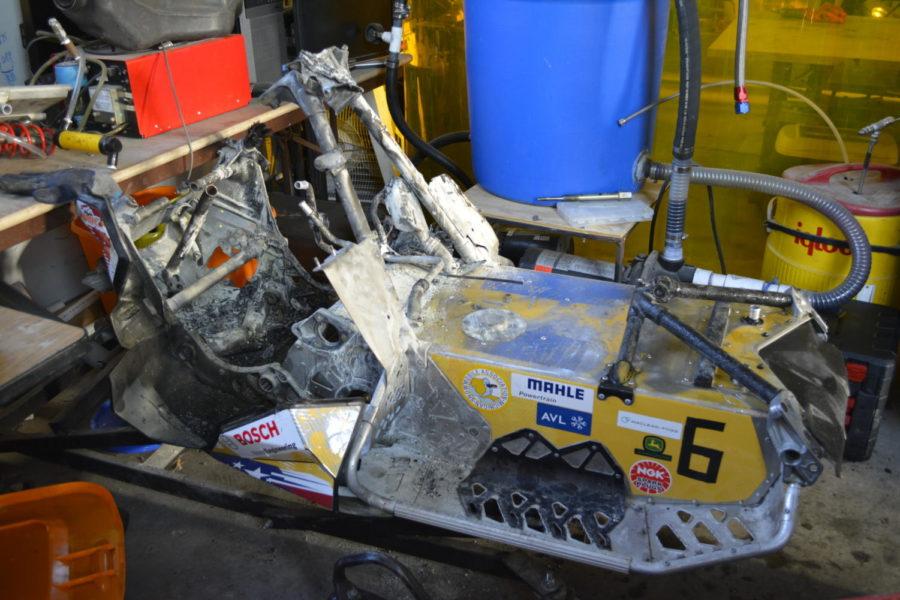SAE Snowmobile team allows students opportunity to change industry
Katlyn Campbell/Iowa State Daily
A snowmobile built by the Clean Snowmobile SAE, Society of Automotive Engineers, team caught fire at one of their competitions. Jason Whited, vice president of the SAE club was not at the event when the snowmobile caught fire. “I asked them about it later and they dubbed it a ‘thermal event'”.
October 4, 2017
After a thermal event that ended with their vehicle in flames, the Iowa State Clean Snowmobile Challenge team is heading back to the drawing board with big plans for next year’s competition.
The Society of Automotive Engineers (SAE) International association holds an annual competition each year that encourages college teams from around the world to redesign existing snowmobile technology to be more fuel efficient and quieter on the trails.
In previous years, park rangers from popular national parks have gone to the competitions to give talks to the competitors about the importance of advancing cleaner and quieter snowmobiles.
“We take a stock snowmobile and our goal is to make it more fuel-efficient and quieter, while also making it fun to ride,” said Charlie Bootsmiller, project director for the SAE Clean Snowmobile Challenge this year.
The SAE Clean Snowmobile Challenge is a competition that pits multiple colleges from around the world to modify and create a better snowmobile. The competition is primarily an engine competition, said the members of the team. However, that doesn’t prevent them from modifying other things on the sled.
“You can touch literally anything you want on the entire snowmobile as long as it still meets the rules,” said Austin Dewberry, project director for this year’s team. “There’s not many things that are against the rules, so anything you see on the snowmobile, or you can think of, you can do.”
The team members also said that while you can modify most anything on the snowmobile, the majority of teams stay away from modifying the chassis due to the fact that the competition requires intricate geometrical analysis of a redesigned chassis for safety reasons.
Other things that most teams modify are centered around the engine, tracks, suspension, skis and everything else that goes onto the chassis, said Dan Zimmerman, engine team lead for the project this year.
This year, the team will be running a backup snowmobile from a few years ago due to a “thermal event,” as the team called it, that saw their primary snowmobile catch fire during the 2017 competition.
The snowmobile is powered by a 800cc, 140 horsepower two-stroke engine. A two-stroke engine is different from the engine you would find in your car due to the number of strokes it takes to turn the crankshaft in the engine. For example, most modern cars on the road feature a four-stroke engine.
The competition is primarily broken up into three classes, separated by type engine: internal combustion, diesel utility and zero emission. While the team said that the 2018 competition will not have a zero emission category, they will be competing in the internal combustion class.
“We had a few team members in the past who wanted to put a diesel motor in our chassis,” said Zimmerman, “but we’ve decided against it each year due to resources and time.”
For this upcoming competition season, the team has a few goals it hopes to achieve in terms of vehicle modification.
“We for sure want to do a standalone ECU,” said Dewberry.
An ECU, or engine control unit, is a device that controls how an internal combustion engine performs and allows for a user to tune specifically how that engine performs.
“For most any vehicle, they have aftermarket applications that are just plug and play, but for a two-stroke application, there’s nothing like that that exists currently,” Dewberry said.
“We’re throwing a lot of ideas around,” said Zimmerman. “We might put in a 600[cc] two-stroke engine so it lowers our horsepower. If we run the 800cc, we’ll probably have to put a rev-limiter on it so we don’t go over the horsepower limit for the competition.”
The team will be traveling to Michigan’s Upper Peninsula in March 2018 to Houghton, Michigan, where they will be competing against other collegiate teams from around the world to develop and push the boundaries of the snowmobile industry.
Bootsmiller went on to talk about the club and how they encourage students from all backgrounds to consider joining.
“I joined my freshmen year without really knowing anything about snowmobiles,” Bootsmiller said. “We have a slightly smaller learning curve than other SAE teams because we’re not building a vehicle from the ground up and I think that makes us a little more approachable.”
















